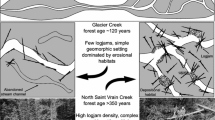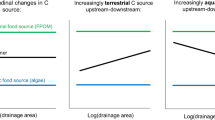Abstract
Ecosystems are connected through fluxes of nutrients, organic matter, and organisms. Disturbances that alter structure and function of one ecosystem may have consequences for other linked ecosystems. We investigated how wildfire and subsequent debris flows altered fluxes of invertebrates from tributaries in the Salmon River Basin, Idaho, USA. We compared fluxes of invertebrates downstream through drift and laterally via insect emergence from streams with varying disturbance histories (unburned, burned, and burned + debris flow) during two summers (3–4 years post fire and 2–3 years post debris flow). We observed that the combination of wildfire and debris flow increased the biomass export of invertebrates from tributaries to main-stem ecosystems 2–3 × compared to other streams. In contrast, aquatic insect emergence did not differ in magnitude among streams of different disturbance histories, but instead diverged in timing. Underwater surveys indicated trout in the main-stem river selected confluence habitats, with a tendency for stronger selection of confluences with burned streams. In a behavioral comparison between confluence and non-confluence habitats, rates of agonistic behavior were 4–6 × higher in confluence areas, indicating that confluences may be worth defending. Abundances of web-spinning spiders that depend on emerging insects did not vary with disturbance history in early-mid summer, but tended to be highest in riparian areas along burned streams by August. Because wildfire and debris flows are predicted to increase, our results elucidate potential pathways by which altered disturbance regimes may affect coupled aquatic-terrestrial ecosystems.






Similar content being viewed by others
References
Baxter CV, Fausch KD, Sanders WC (2005) Tangled webs: reciprocal flows of invertebrate prey link streams and riparian zones. Freshw Biol 50:201–220. https://doi.org/10.1111/j.1365-2427.01328x
Baxter CV, Kennedy TA, Miller SW, Muehlbauer JD, Smock LA (2017) Macroinvertebrate drift, adult insect emergence and oviposition. In: Hauer RF, Lamberti GA (eds) Methods in stream ecology, 3rd edn. Academic Press, San Diego, pp 435–456
Benda L, Poff NL, Miller D, Dunne T, Reeves G, Pess G, Pollock M (2004) The network dynamics hypothesis: how channel networks structure riverine habitats. Bioscience 54:413–427. https://doi.org/10.1641/006-3548(2004)054%5B0413:tndhhc%5D2.0.co;2
Benjamin JR, Fausch KD, Baxter CV (2011) Species replacement by a nonnative salmonid alters ecosystem function by reducing prey subsidies that support riparian spiders. Oecologia 167:503–512. https://doi.org/10.1007/s00442-011-2000-6
Benke AC, Huryn AD, Smock LA, Wallace JB (1999) Length-mass relationships for freshwater macroinvertebrates in North America with particular reference to the southeastern United States. J North Am Benthol Soc 18:308–343
Bigelow PE, Benda LE, Miller DJ, Burnett KM (2007) On debris flow, river networks, and the spatial structure of channel morphology. For Sci 53:220–238
Bixby RJ, Cooper SD, Gresswell RE, Brown LE, Dahm CN, Dwire KA (2015) Fire effects on aquatic ecosystems: an assessment of the current state of the science. Freshw Sci 34:1340–1350. https://doi.org/10.1086/684073
Cover MR, de la Fuente JA, Resh VH (2010) Catastrophic disturbances in headwater streams: the long-term ecological effects of debris flows and debris floods in the Klamath Mountains, northern California. Can J Fish Aquat Sci 67:1596–1610. https://doi.org/10.11139/f10-079
Davis JM, Rosemond AD, Small GE (2011) Increasing donor ecosystem productivity decreases terrestrial consumer reliance on a stream resource subsidy. Oecologia 167:821–834. https://doi.org/10.1007/s00442-011-2026-9
Davis JM, Baxter CV, Rosi-Marshall EJ, Pierce JL, Crosby BT (2013) Anticipating stream ecosystem responses to climate change: towards predictions that incorporate effects via land-water linkages. Ecosystems 16:909–922. https://doi.org/10.1007/s10021-013-9653-4
Fausch KD (1984) Profitable stream positions for salmonids: relating specific growth rate to net energy gain. Can J Fish Aquat Sci 62:441–451
Franssen NR, Gido KB, Guy CS, Tripe JA, Shrank SJ, Strakosh TR, Bertrand KN, Franssen CM, Pitts KL, Paukert CP (2006) Effects of floods on fish assemblages in an intermittent prairie stream. Freshw Biol 51:2072–2086. https://doi.org/10.1111/j.1365-2427.2006.01640.x
Gelman A (2013) P values and statistical practice. Epidemiology 24:69–72. https://doi.org/10.1097/EDE.0b013e31827886f7
Gerking SD (1994) Feeding ecology of fish. Academic Press, San Diego
Gerstman BB (2014) Basic biostatistics. Jones and Bartlett Publishers, Sudsbury
Gomi T, Sidle RC, Richardson JS (2002) Understanding processes and downstream linkages of headwater streams. Bioscience 52:905–916. https://doi.org/10.1641/0006-3568(2002)052%5B0905:upadlo%5D2.0.co;2
Goode JR, Luce CH, Buffington JM (2012) Enhanced sediment delivery in a changing climate in semi-arid mountain basins: implications for water resource management and aquatic habitat in the northern Rocky Mountains. Geomorphology 140:1–15. https://doi.org/10.1016/j.geomorph.2011.06.021
Gresswell RE (1999) Fire and aquatic ecosystems in forested biomes of North America. Trans Am Fish Soc 128:193–221
Gurnell AM, Piégay H, Swanson FJ, Gregory SV (2002) Large wood and fluvial processes. Freshw Biol 47:601–619
Harris HE, Baxter CV, Davis JM (2015) Debris flows amplify effects of wildfire on magnitude and composition of tributary subsidies to main-stem habitats. Freshw Sci 34:1457–1467. https://doi.org/10.1086/684015
Hughes TP, Connell JH (1999) Multiple stressors on coral reefs: a long-term perspective. Limnol Oceanogr 44:932–940
Huryn AD, Wallace JB (2000) Life history and production of stream insects. Annu Rev Entomol 45:83–110. https://doi.org/10.1146/annurev.ento.45.1.83
Hynes HBN (1975) The stream and its valley. Int Vereinigung für theoretische angewandte Limnologie 19:1–15
Isaak DJ, Rieman BE (2013) Stream isotherm shifts from climate change and implications for distributions of ectothermic organisms. Glob Change Biol 19:742–751. https://doi.org/10.1111/gcb.12073
Issak DJ, Wenger SJ, Young MK (2017) Big biology meets microclimatology: defining thermal niches of ecotherms at landscape scales for conservation planning. Ecol Appl 27:997–990. https://doi.org/10.1002/eap.1501
Jackson JK, Fisher SG (1986) Secondary production, emergence, and export of aquatic insects of a Sonoran Desert stream. Ecology 67:629–638
Junk WJ, Bayley PB, Sparks RE (1989) The flood pulse concept in river-floodplain systems. Can Spec Public Fish Aquat Sci 106:110–127
Kato C, Iwata T, Nakano S, Kishi D (2003) Dynamics of aquatic insect flux affects distribution of riparian web-building spiders. Oikos 103:113–120. https://doi.org/10.1034/j.1600-0706.2003.12477.x
Kiffney PM, Greene CM, Hall JE, Davies JR (2006) Tributary streams create spatial discontinuities in habitat, biological productivity, and diversity in main-stem rivers. Can J Fish Aquat Sci 63:2518–2530. https://doi.org/10.1139/f06-138
Malison RL, Baxter CV (2010) The fire pulse: wildfire stimulates flux of aquatic prey to terrestrial habitats driving increases in riparian consumers. Can J Fish Aquat Sci 67:570–579. https://doi.org/10.1139/f10-006
Marczak LB, Richardson JS (2008) Growth and development rates in a riparian spider are altered by asynchrony between the timing and amount of a resource subsidy. Oecologia 156:249–258. https://doi.org/10.1007/s00442-008-0989-y
Marczak LB, Thompson JM, Richardson JS (2007) Meta-analysis: trophic level, habitat, and productivity shape the food web effects of resource subsidies. Ecology 88:140–148. https://doi.org/10.1890/0012-9658
May CL (2007) Sediment and wood routing in steep headwater streams: an overview of geomorphic processes and their topographic signatures. For Sci 54:119–130
McNaughton SJ (1992) The propagation of disturbance in savannas through food webs. J Veg Sci 3:301–314
Merritt RW, Cummins KW, Berg MB (eds) (2008) An Introduction to the aquatic insects of North America, 4th edn. Kendall/Hunt Publishing Co, Dubuque
Miller D, Luce C, Benda L (2003) Time, space, and episodicity of physical disturbances in streams. For Ecol Manag 178:121–140. https://doi.org/10.1016/s0378-1127(03)00057-4
Minshall GW (2003) Responses of stream benthic macroinvertebrates to fire. For Ecol Manag 178:155–161. https://doi.org/10.1016/s0378-1127(03)0059-8
Nakano S, Murakami M (2001) Reciprocal subsidies: dynamic interdependence between terrestrial and aquatic food webs. Proc Natl Acad Sci 98:166–170. https://doi.org/10.1073/pnas.98.1.116
Odum EP (1985) Trends expected in stressed ecosystems. Bioscience 35:419–422
Osborne LL, Wiley MJ (1992) Influence of tributary spatial position in the structure of warmwater fish communities. Can J Fish Aquat Sci 49:671–681
Payette National Forest (2010) Bald Hill prescribed burn project environmental assessment. United States Department of Agriculture Forest Service. Project Record 40 CFR 1502.21
Polis GA, Anderson WB, Holt RD (1997) Toward an integration of landscape and food web ecology: the dynamics of spatially subsidized food webs. Annu Rev Ecol Syst 28:289–316
Power ME, Rainey WE, Parker MS, Sabo SL, Smyth A, Khandwala S, Finlay JC, McNeely RC, Marsee K, Anderson C (2004) River-to-watershed subsidies in an old growth conifer forest. In: Polis GA, Power ME, Huxel GR (eds) Food Webs at the Landscape Level. University of Chicago Press, Chicago, pp 217–240
Rader RB (1997) A functional classification of the drift: traits that influence availability to salmonids. Can J Fish Aquat Sci 54:1211–1234
Rice SP (2017) Tributary connectivity, confluence aggradation and network biodiversity. Geomorphology 277:6–16
Rice SP, Roy AG, Rhoads BL (eds) (2008) River confluences, tributaries and the fluvial network. Wiley, Hoboken
Rugenski AT, Minshall GW (2014) Climate-moderated responses to wildfire by macroinvertebrates and basal food resources in montane wilderness streams. Ecosphere 5:25. https://doi.org/10.1890/ES13-00236.1
Sabo JL, Bastow JL, Power ME (2002) Length-mass relationships for adult aquatic and terrestrial invertebrates in a California watershed. J North Am Benthol Soc 21:336–343. https://doi.org/10.2307/1468420
Sanzone DM, Meyer JL, Gardiner EP, Tank JL, Grimm NB (2003) Carbon and nitrogen transfer from a desert stream to riparian predators. Oecologia 134:238–250. https://doi.org/10.1007/s00442-002-1113-3
Scarnecchia DL, Roper BB (2000) Large-scale, differential summer habitat use of three anadromous salmonids in a large river basin in Oregon, USA. Fish Manag Ecol 7:197–209. https://doi.org/10.1046/j.1365-2400.2000.00196.x
Siler ER, Wallace JB, Eggert SL (2001) Long-term effects of resource limitation on stream invertebrate drift. Can J Fish Aquat Sci 58:1624–1637. https://doi.org/10.1139/f01-101
Spiller DA, Piovia-Scott J, Wright AN, Yang LH, Takimoto G, Schoener TW, Iwata T (2010) Marine subsidies have multiple effects on coastal food webs. Ecology 91:1424–1434. https://doi.org/10.1890/09-0715.1
Torgerson CE, Gresswell RE, Bateman DS, Burnett KM (2008) Spatial identification of tributary impacts in river networks. In: Rice SP, Roy AG, Rhoad RL (eds) River confluences, tributaries and the fluvial network. Wiley, Hoboken, pp 159–181
Turner MG (2010) Disturbance and landscape dynamics in a changing world. Ecology 91:2833–2849. https://doi.org/10.1890/10-0097.1
Ubick D, Paquin P, Cushing PE, Roth V (2005) Spiders of North America: an identification manual. American Arachnological Society, Poughkeepsie
Vannote RL, Minshall GW, Cummins KW, Sedell JR, Cushing CE (1980) The river continuum concept. Can J Fish Aquat Sci 37:130–137. https://doi.org/10.1139/f80-017
Wenger SJ, Isaak DI, Luce CE, Neville HM, Fausch KD, Dunham JB, Dauwalter DE, Young MK, Elsner MM, Rieman BE, Hamlet AF, Williams JE (2011) Flow regime, temperature, and biotic interactions drive differential declines of trout species under climate change. Proc Natl Acad Sci 108:14175–14180. https://doi.org/10.1073/pnas.1103097108
Westerling AL, Hidalgo HG, Cayan DR, Swetnam TW (2006) Warming and earlier spring increase western US forest wildfire activity. Science 313:940–943. https://doi.org/10.1126/science.1128834
Wipfli MS, Baxter CV (2010) Linking ecosystems, food webs, and fish production: subsidies in salmonid watersheds. Fish 35:373–385. https://doi.org/10.1577/1548-8446-35.8.373
Wipfli MS, Gregovich DP (2002) Export of invertebrates and detritus from fishless headwater streams in southeastern Alaska: implications for downstream salmonid production. Freshw Biol 47:957–969. https://doi.org/10.1046/j.1365-2427.2002.00826.x
Acknowledgements
This research was supported by United States Forest Service Payette National Forest, National Science Foundation’s Experimental Program to Stimulate Competitive Research in Idaho (EPS-08-14387), and a University Research Committee Grant at Idaho State University. We thank R. Nelson and C. Zurstadt of the Payette National Forest and R. Arkle and D. Pilliod of the United States Geological Survey for help with research logistics. We thank M. Apple A. Bell, R. Blackadar, S. Collins, J. Cornell, K. Heinrich, M. Schenk, and A. Steele for research assistance, and T. Bowyer and K. Aho for statistical advice.
Author information
Authors and Affiliations
Corresponding author
Rights and permissions
About this article
Cite this article
Harris, H.E., Baxter, C.V. & Davis, J.M. Wildfire and debris flows affect prey subsidies with implications for riparian and riverine predators. Aquat Sci 80, 37 (2018). https://doi.org/10.1007/s00027-018-0589-9
Received:
Accepted:
Published:
DOI: https://doi.org/10.1007/s00027-018-0589-9




